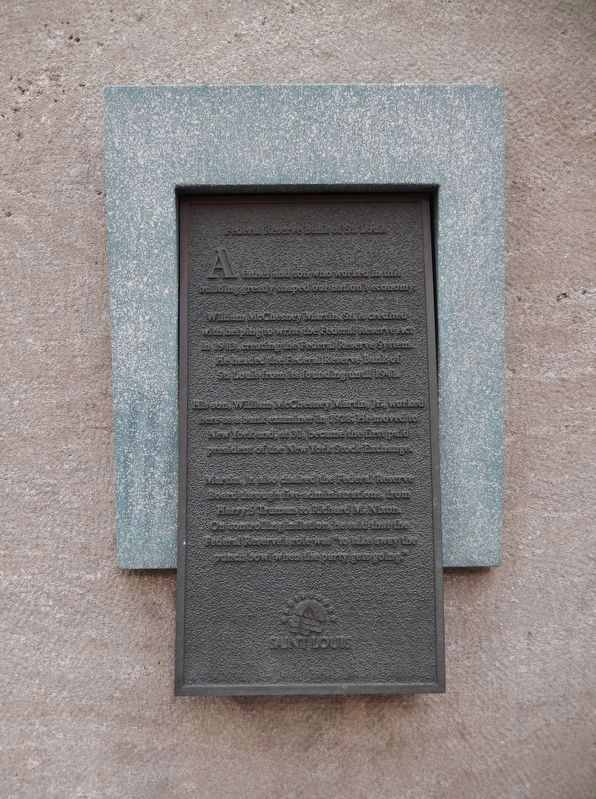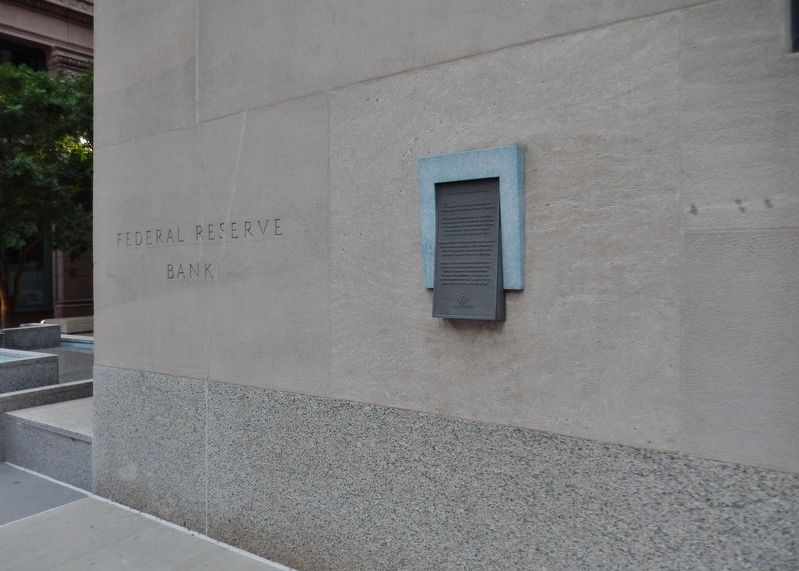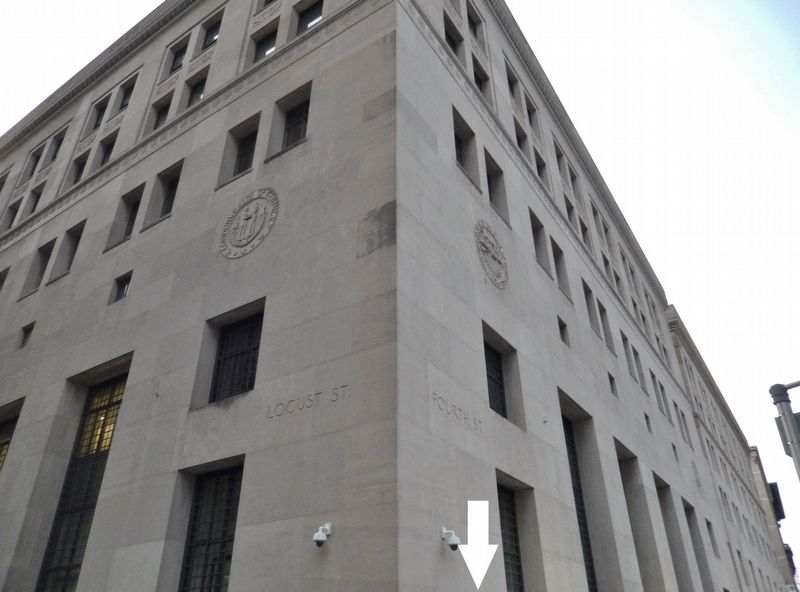Downtown in St. Louis, Missouri — The American Midwest (Upper Plains)
Federal Reserve Bank of St. Louis
William McChesney Martin, Sr. is credited with helping to write the Federal Reserve Act in 1913, creating the Federal Reserve System. He headed the Federal Reserve Bank of St. Louis from its founding until 1941.
His son, William McChesney Martin, Jr., worked here as a bank examiner in 1928. He moved to New York and, at 31, became the first paid president of the New York Stock Exchange.
Martin, Jr. also chaired the Federal Reserve Board through five administrations, from Harry S. Truman to Richard M. Nixon. On controlling inflation, he said that the Federal Reserveís role was “to take away the punch bowl when the party gets going.”
Topics and series. This historical marker is listed in this topic list: Industry & Commerce. In addition, it is included in the Former U.S. Presidents: #33 Harry S. Truman, and the Former U.S. Presidents: #37 Richard M. Nixon series lists. A significant historical year for this entry is 1913.
Location. 38° 37.702′ N, 90° 11.265′ W. Marker is in St. Louis, Missouri. It is in Downtown. Marker is at the intersection of North 4th Street and Locust Street (Federal Reserve Bank Plaza), on the left when traveling north on North 4th Street. Marker is mounted at eye-level, directly on the subject building, near the southeast corner of the building, facing east toward 4th Street. Touch for map. Marker is at or near this postal address: 1 Federal Reserve Bank Plaza, Saint Louis MO 63102, United States of America. Touch for directions.
Other nearby markers. At least 8 other markers are within walking distance of this marker. Teenager Samuel Clemens (within shouting distance of this marker); The Security Building (within shouting distance of this marker); William Tecumseh Sherman (about 300 feet away, measured in a direct line); Merchant Laclede Building (about 400 feet away); William Clark died at this site (about 400 feet away); The Mississippi Valley Trust Company (about 500 feet away); The Missouri Athletic Club (about 600 feet away); Site of First Mormon Meeting Place in St. Louis (about 600 feet away). Touch for a list and map of all markers in St. Louis.
More about this marker. Marker is a large metal plaque, mounted within a decorative polished granite frame.
Also see . . .
1. Federal Reserve Act (1913). The bill called for a system of eight to twelve mostly autonomous regional Reserve Banks that would be owned by commerical banks and whose actions would be coordinated by a committee appointed by the President. The Federal Reserve System would then become a privately owned banking
system that was operated in the public interest. Bankers would run the twelve Banks, but those Banks would be supervised and by the Federal Reserve Board whose members included the Secretary of the Treasury, the Comptroller of the Currency, and other officials appointed by the President to represent public interests. (Submitted on August 27, 2018, by Cosmos Mariner of Cape Canaveral, Florida.)
2. William McChesney Martin Sr. Martin helped draft the Federal Reserve Act, then became the first chairman of the board of directors and Federal Reserve agent of the St. Louis Fed on September 1, 1914. During World War I, Martin also served as chairman of the St. Louis Fed committee on capital issues. He eventually assumed the role of governor of the Bank in 1929. The title of governor was changed to president, and Martin remained president until 1941. (Submitted on August 27, 2018, by Cosmos Mariner of Cape Canaveral, Florida.)
3. William McChesney Martin Jr. William McChesney Martin Jr. took office as chairman of the Board of Governors of the Federal Reserve System on April 2, 1951, and served until January 30, 1970. He served under five different presidents. In 1941, he was drafted into the US Army. By the end of World War II, he was a colonel and was nominated by President Harry Truman to lead the Export-Import Bank of the United States. From February 1949 to April 1951, Martin served as assistant secretary of the Treasury.
Martin was known for his tight money policies and anti-inflation bias.
In 1956, he famously described the Fedís purpose to Congress as “leaning against the winds of deflation or inflation, whichever way they are blowing.” (Submitted on August 27, 2018, by Cosmos Mariner of Cape Canaveral, Florida.)
Credits. This page was last revised on January 30, 2023. It was originally submitted on August 26, 2018, by Cosmos Mariner of Cape Canaveral, Florida. This page has been viewed 599 times since then and 133 times this year. Photos: 1, 2, 3. submitted on August 27, 2018, by Cosmos Mariner of Cape Canaveral, Florida. • Bill Pfingsten was the editor who published this page.


